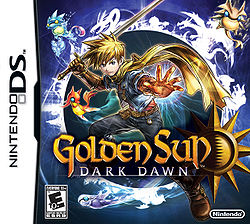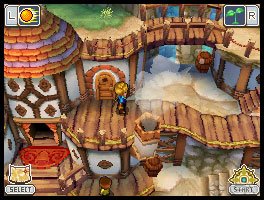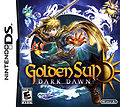User:Dkpat/darkdawn: Difference between revisions
m (minor, might continue to fix later.) |
(→Development: expand) |
||
| Line 57: | Line 57: | ||
==Development== | ==Development== | ||
Originally shown as "Golden Sun DS," the game was revealed to have the subtitle "Dark Dawn" on June 15, 2010. The [[Takahashi Brothers]] describe this subtitle as "core to the story" and that it will become relevant and understandable as the story goes on, but they say that because "Dark" and "Dawn" are essentially opposites, it can be thought of as "darkness and light, destruction and revival." | Originally shown as "Golden Sun DS," the game was revealed to have the subtitle "Dark Dawn" on June 15, 2010. The [[Takahashi Brothers]] describe this subtitle as "core to the story" and that it will become relevant and understandable as the story goes on, but they say that because "Dark" and "Dawn" are essentially opposites, it can be thought of as "darkness and light, destruction and revival." On July 14, 2010, Japanese magzine ''Weekly Shōnen Jump'' announced Japanese subtitle "漆黒なる夜明け" with character design of Matthew, Tyrell and Karis. On [http://bbs.ffsky.com/showtopic-1713626.aspx July 22], ''Famitsu'' interview with producer Takahashi Brothers, Hiroyuki said "The two predecessors were prologue of series, this book is main entry”. | ||
An [http://press.nintendo.com/articles.jsp?id=25161 August 30, 2010] press release describes the premise like so: ''"Taking place 30 years after the events of ''[[Golden Sun]]'' and ''[[Golden Sun: The Lost Age]]'' for the Game Boy™ Advance system, ''Golden Sun: Dark Dawn'' introduces a new generation of heroes that are struggling to survive in a radically changed world. What begins as a simple journey to rescue a lost friend turns into a dramatic quest to save the land from catastrophe as players are drawn into a world full of magical energy."'' | On August 18, 2010, Japanese official website was set up. An [http://press.nintendo.com/articles.jsp?id=25161 August 30, 2010] press release describes the premise like so: ''"Taking place 30 years after the events of ''[[Golden Sun]]'' and ''[[Golden Sun: The Lost Age]]'' for the Game Boy™ Advance system, ''Golden Sun: Dark Dawn'' introduces a new generation of heroes that are struggling to survive in a radically changed world. What begins as a simple journey to rescue a lost friend turns into a dramatic quest to save the land from catastrophe as players are drawn into a world full of magical energy."'' On September 2, 2010, Japanese official website announce the game would publish on October 28, 2010. On October 20, Fami scored the game 33/40. | ||
==Reception== | ==Reception== | ||
Revision as of 07:18, 21 May 2012
| Golden Sun: Dark Dawn | |
|---|---|

| |
| Developer(s) | Camelot Software Planning |
| Publisher(s) | Nintendo |
| Composer(s) | Motoi Sakuraba |
| Series | Golden Sun |
| Platform | Nintendo DS |
| Release Date | Japan: 28 October 2010 North America: 29 November 2010 Australia: 2 December 2010 Europe: 10 December 2010 |
| Genre | Hand-held role-playing game |
| Ratings | CERO=A ESRB=E10+ PEGI=12+ |
| Media | Nintendo DS cartridge |
Golden Sun: Dark Dawn (黄金の太陽 漆黒なる夜明, Ōgon no Taiyō: Shikkokunaru Yoake), announced June 2, 2009 at E3 2009, is the third game in the Golden Sun series. Originally shown as "Golden Sun DS," the game was revealed to have the subtitle "Dark Dawn" on June 15, 2010.
The announcement of this title came over five years after the release of The Lost Age in 2003, something that the game director Shugo Takahashi had expressed "more than a fair bit of regret about." [1].
For information about hoaxes and fan speculation prior to this game's confirmation, see Golden Sun 3 Prerelease Speculation.
Plot
Setting

The game takes place 30 years after the end of Golden Sun: The Lost Age, at the end of which Alchemy had been returned to the world of Weyard via the tumultuous Golden Sun event. The lands were all rearranged and changed by the chaos, and new nations have founded themselves throughout the continents of the world even as all manner of ancient ruins and technology have been unearthed in various locations.
Gameplay Features

The game features a world with 3D environments and entirely 3D battles, and it features optional touch-screen stylus control. Stylus control is an additional way of controlling the functions that can otherwise be handled with the base control scheme from previous games, with touchable icons on screen that quickly and easily select and use Psynergy shortcuts.
Eight all-new playable characters comprise the eventual final party, and unlike in previous games where there would be four characters at first and then suddenly jump up to eight, the full party is assembled at a steady rate as the game progresses. Characters are more-or-less similar in battle to previous games, but one of the characters, Sveta, has an entirely different battle style in which she transforms between humanoid and werewolf forms, where even her Attack and Defend commands are altered. Once again, there are 72 Djinn to collect, 18 for each element and therefore 9 for allocation to each of the eight playable characters; however, some of the Djinn themselves are different. Some of the otherwise missing Venus and Mars Djinn are present on adult Isaac and Garet, who join battles as uncontrolled "guest" characters in the beginning stages of the game. Each Djinni now has a unique design variation to differentiate it from all of the other Djinn of the same element.
The Class system is very similar to the original games in terms of how Djinn influence them, but in accordance with the new characters there are four new mono-element classes and two new dual-element classes, and some of the existing classes have been slightly retooled, such as with the Wind Seer series now having its own party-healing Psynergy. Classes provided by Class-changing items like in The Lost Age no longer exist, however.
All 29 Summon spirits from the Game Boy Advance titles return in Dark Dawn, redesigned for 3D presentation, with a few being changed more drastically, such as Boreas. One all-new summon, a Venus-aligned summon named Crystallux, was added, and appears identical to the chandelier in the "Culture Advanced" commercial for the original Golden Sun. This makes for a total of an even 30, and like in The Lost Age, the party starts out with access to the "initial 16" and must collect the other 14 by finding their Summon Tablets in the game world. Djinn that are on Standby now wander around the top screen of the DS in 2D while the battle takes place in 3D below. When a summon is used, the appropriate amount of Djinn will be removed from the top screen.
- MOVE PSYNERGY SCREENSHOT HERE?***************
Psynergy old and new make fully 3D appearances as well, such as the Move Psynergy which is used to shift objects around. Growth, is now inherent to Matthew regardless of class series (without its upgraded forms, mad Growth and Wild Growth), so that he can use it as a utility Psynergy effect without having to constantly change classes, as was required in the original games.
Items and their categories are similar to the previous games, but with several important changes and additions. Staffs have been divided into Staffs and Ankhs, the latter of which is a more restricted sub-category. Bows are introduced as an all-new weapon type and Sveta uses her own category of weapons called Claws. Defensive equipment on the whole is less changed, though Shirts have been removed as supplementary equipment, while Rings have more of an emphasis on increasing stats, where before they had been almost solely about being usable items. Every weapon in the game has its own, unique 3D model that appears held by a character during battle. All weapons have Unleash effects, and most have multiple unleashes. Weapons will unlock unleashes when the character gains experience with the weapons in battle in a new weapon-experience system. Unleashes themselves have a wider array of effects as well, such as being able to hit all enemies on the battlefield at once.
Battle is very similar to the previous games, in that a party of four characters fights an enemy group, reserve party members may be switched in once per turn, and when the first party is all downed, the reserve party jumps in. Perhaps the most critical change is that when a character is set to attack an enemy, but another character has defeated that enemy beforehand in the same turn, the character will no longer automatically Defend; their attack will be redirected to another enemy on the battlefield.
There is no connectivity with Golden Sun: The Lost Age, even though GBA games can be inserted in the GBA slot of older DS systems. Furthermore, there is no Easy mode or Hard mode to replay the game with.
Walkthrough
See the quick spoiler-free walkthrough for a "perfect" rundown of the game's progression and secrets in a general overview style.
Tricks and Secrets
See the full list of glitches, tricks, and secrets here.
Development
Originally shown as "Golden Sun DS," the game was revealed to have the subtitle "Dark Dawn" on June 15, 2010. The Takahashi Brothers describe this subtitle as "core to the story" and that it will become relevant and understandable as the story goes on, but they say that because "Dark" and "Dawn" are essentially opposites, it can be thought of as "darkness and light, destruction and revival." On July 14, 2010, Japanese magzine Weekly Shōnen Jump announced Japanese subtitle "漆黒なる夜明け" with character design of Matthew, Tyrell and Karis. On July 22, Famitsu interview with producer Takahashi Brothers, Hiroyuki said "The two predecessors were prologue of series, this book is main entry”.
On August 18, 2010, Japanese official website was set up. An August 30, 2010 press release describes the premise like so: "Taking place 30 years after the events of Golden Sun and Golden Sun: The Lost Age for the Game Boy™ Advance system, Golden Sun: Dark Dawn introduces a new generation of heroes that are struggling to survive in a radically changed world. What begins as a simple journey to rescue a lost friend turns into a dramatic quest to save the land from catastrophe as players are drawn into a world full of magical energy." On September 2, 2010, Japanese official website announce the game would publish on October 28, 2010. On October 20, Fami scored the game 33/40.
Reception
Gallery
- GSDDMatthew.jpg
Official promotional art of Matthew
- GSDDKaris.jpg
Official promotional art of Karis
- GSDDTerrell.jpg
Official promotional art of Tyrell
Official promotional art of Rief
Official promotional art of Amiti
- Stella.png
Official promotional art of Sveta
Official promotional art of Eoleo
- Img himi.jpg
Official promotional art of Himi
- DDIsaac.png
Official promotional art of Isaac
- KradenDD.png
Official promotional art of Kraden
- GSSpade.jpg
Official promotional art of Blados
- GSHeart.jpg
Official promotional art of Chalis
- GSDDAce.jpg
Official promotional art of Arcanus
Matthew at Patcher's Place.
Matthew at Konpa Ruins.
Matthew walking through Patcher's Place, with a Mars Djinni "Forge" visible above.
Atalanta summon sequence
Offical art of Isaac's Lookout Cabin
Official art of Patcher's Place
Official art of Goma Plateau
Trivia
- The August 2009 issue of the U.K.-circulated Official Nintendo Magazine made the erroneous claim that the main playable character seen in the E3 trailer, later known as Matthew, was Isaac himself, rather than a descendant of Isaac as confirmed by the E3 press release. [2] Nintendo Power reported him to be Isaac's son beforehand.
- At the end of Dark Dawn, the screen shown "The End ...?" in American games, but in the Japanese version, the screen only displays "The End" without the ellipsis and question mark.
External Links
| Golden Sun games and media | |
|---|---|
| Main Series Games | Golden Sun • Golden Sun: The Lost Age • Golden Sun: Dark Dawn |
| Cameos: | Super Smash Bros. Brawl & Ultimate |
| Other Media: | 4-Koma Gag Battle • Dark Dawn V-Jump manga |
| Other Information: | Game data directory • GBA plot summary • Dark Dawn plot summary • Staff Credits |

















